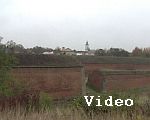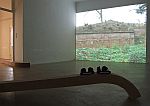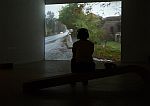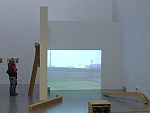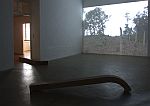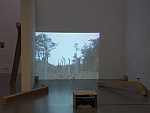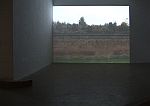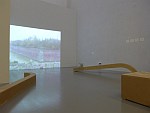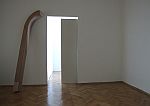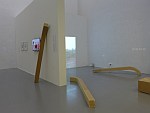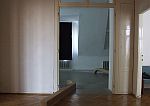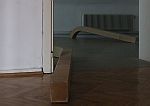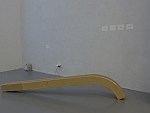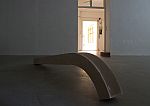Video, 2009-2011
5 channels, 51:03 min
1 beamer
3 loudspeakers
2 wireless headphones, each with a audio-collage
Incomplete
Objects, 2011
MDF-plates, nails, filler
234-240 cm x 13,5 cm x 16 cm
The starting point of the exhibition in the VBKÖ (Association of Women Artists in Austria) in Vienna was a reflection on the Vienna-born artist Friedl Dicker-Brandeis who was murdered in Auschwitz. In 1926 she exhibited in a group show in the VBKÖ. Friedl Dicker-Brandeis was one of the first students of Bauhaus, active in the communist resistance in the period of National Socialism and persecuted as a Jew. Before she was murdered, she was imprisoned in Theresiestadt where she gave art lessons to children. Some of her students - the girls from Room 28 - survived. In the course of their research Johanna Tinzl and Stefan Flunger have contacted three of them, which resulted in an intense collaboration.
During several meetings with Anna Flachová-Hanusova, Helga Pollak-Kinsky and Ela Stein Weissberger Johanna Tinzl and Stefan Flunger made video and sound recordings. The development of an open interview situation should allow review, storytelling and the self-representation of the women, beyond an objectification as witnesses of that time. The artistic process, the selection and the processing of the material took place in exchange and consensus with the three protagonists. The intense relationship among the three women and their composure in front of the camera becomes comprehensible seeing the video of the artists. The title simply is composed of the names of the three persons filmed.
The approach of Johanna Tinzl and Stefan Flunger to the topic began with a trip to Terezin, the former KZ Theresienstadt. Their first route was a circumnavigation of the concentration camp and led them to their video work »I don't have much more to say about the wall, except it kept us well inside«.
Filmed with a shaky hand-camera the entire complex of Theresienstadt, today Terezin, is shown from the outside. The view passes by walls, fences, barbed wire, away across a street in walking speed. You can hear the steps of the filmmakers, rustling leaves, cars passing by and the wind in the microphone. A second sound-level is formed by current recordings with the women: Songs of the children's opera »Brundibár« which they performed together in the concentration camp and the singing and piano play of Anna-Flachová Hanusova who made a career as a singer and a pianist after her liberation. Among others she plays Chopin and Schumann and sings Brahms' »Good evening, good night« (»Lullaby«). The verses of the song: »By morning if God wills you'll be woken again« obtain a painfully true dimension considering the fact that the singer survived the Holocaust and thereby escaped the Nazi death machinery at random.
The charging of the despicable scenery with the music does not lead into a kitsch of remembrance, since the recording is not a soundtrack which should activate the affects of the viewers only. This is embodiment itself. The presentation stays entirely contemporary, its fragility stems from the aged and at the same time lively voices which sing the combative children's songs and the music of the Romantic that does not project on the soulful landscape, but faces the historic crime scene. Moreover the romantic rapture is hindered by sudden disturbances, such as when the voice of the singer and pianist Anna Flachová-Hanusová interrupts the composition out of a sudden with a note - »That's the magic finger« - on her own piano playing. The subjectivity of the singers is consistently set in the foreground.
Not least in the title »I don't have much more to say about the wall, except it kept us well inside«, which is a quote from Helga Pollak-Kinsky of a conversation about Theresienstadt, Tinzl and Flunger leave the field to the witnesses of that time.
With a consistent view from outside on the grounds of the former concentration camp Theresienstadt the two artists avoid the presumption to track the perspective of the victims from inside the camp. Through this blank space in the visualization, which even disregards the exposure of historical material, they at once enhance the perspective of the survivors and let their memories be heard instead - recordings of narratives from the survivors are transmitted via wireless headphones. They allow the visitors to pass through the exhibition.
»Incomplete«, thus informs us the succinct title of the installation: Raw objects made from sloppy plastered MDF board with an indicated J-shape rest or lean in the exhibition. Their physical presence associates the modernist vocabulary which is not unusual in the contemporary exhibition space with the feeling of the sharding of a dilapidated area – the form of the objects is reflected in the pillars that you see in the video, which have fixed a fence on the outer wall of Terezín once. Even if the fence props originate from the communist era, as the artists found out through their research, they nevertheless invoke immediately Auschwitz in the image of pillar and barbed wire.
As functionless as these pillars in the video might be today, what is associated with them is evidence of barbaric violence. And even when looking at the pillars which lean elegantly against the wall or are overturned in the exhibition space, there will be no triumph over the fact that they can no longer »keep inside well« - as a viewer you can not escape the dimension of the objects.
»Incomplete« or in other words »Not finished yet« - the ambiguity of the title hints to the incompleteness of the socio-political process. At the same time it is pointed out that the present installation and its objects are unfinished and that the material should still be worked on. The title refers to the continuing need of coming to terms with the Nazi crimes. The particle »yet« refers to the common expectation of those who assume that the coming to terms with the past would have been accomplished sufficiently and turns ironically against those who »[want] to draw a line under it and who might if possible raze even itself from memory.« [1]
At the same time it sounds as if the title itself confronts the installation with its lifeless monument-character which appears obsolete in consideration of the narratives of the survivors.
[1] Adorno, Theodor W.: Kulturkritik und Gesellschaft I/II. Gesammelte Schriften, Herausgegeben von Rolf Tiedemann unter Mitwirkung von Gretel Adorno, Susan Buck-Morss und Klaus Schultz, Band 10.2, Frankfurt am Main: 2003, S. 555.
Text: © Katharina Miuschka Witzmann, 2011
